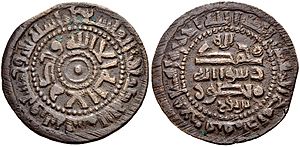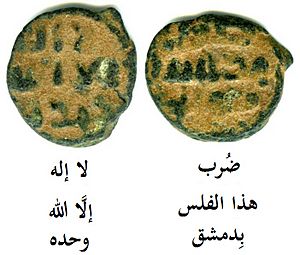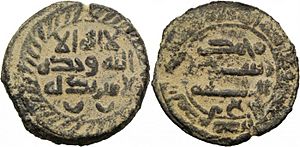Fals facts for kids
The fals (Arabic: فلس, romanized: fals, plural fulus) was a special copper coin used a long time ago. It was first made by a big empire called the Umayyad caliphate (661–750). This happened starting in the late 600s. The name "fals" comes from an even older coin called the follis, which was used by the Romans and later the Byzantines.

Fals coins usually had beautiful Arabic script written on both sides. Different kinds of copper fals coins were made for many centuries, all the way until the 1800s. Their weight could be very different, from just one gram to ten grams or even more.
Today, the word "fals" is still used in spoken Arabic for money, but it's pronounced 'fils'. The word fulus also became part of the Malay language.
Contents
What Was the Fals Coin?
The fals was a copper coin. It was an important part of daily life and trade in the early Islamic world. Unlike gold or silver coins, which were used for larger payments, the fals was used for smaller, everyday purchases. Think of it like the small change we use today.
Where Did the Fals Come From?
The idea for the fals came from an older coin called the follis. This coin was used by the Roman Empire and later by the Byzantine Empire. When the Islamic empire grew, they took ideas from the lands they ruled. They started making their own coins, including the fals, based on these older designs.
Who Made the First Fals Coins?
The first fals coins were made by the Umayyad caliphate. This was a powerful Islamic empire that ruled from 661 to 750 CE. They were important in shaping the early Islamic world, including its money system.
How Fals Coins Looked
Most fals coins had special Arabic script on them. This writing often included religious phrases or the name of the ruler who made the coin. Sometimes, they also had patterns or symbols. The designs changed over time and in different places.
Different Weights and Sizes
Fals coins were not all the same size or weight. Some were small and light, while others were much heavier. Their weight could be anywhere from one gram to over ten grams. This variety shows that different regions and rulers made their own versions of the fals.
The Fals and Other Coins
The fals was one type of coin in a bigger money system. Gold coins, called dinar, and silver coins, called dirham, were also used. The fals (copper) was for small transactions, while dinars (gold) and dirhams (silver) were for larger ones.
Related Coins Today
The name "fals" has influenced other coins. For example, the Fils is a small unit of money used today in some countries. It is a subdivision of larger currencies like the dinar, dirham, or rial. Another coin, the Falus, was used in Morocco from 1672 to 1901.
See also
 In Spanish: Felús para niños
In Spanish: Felús para niños



